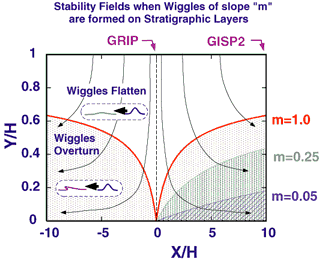 Ice dynamics models are needed to predict areas and conditions of likely disruption for future ice cores. This figure shows where perturbed layers are likely to become overturned and where they are likely to be flattened.
Ice dynamics models are needed to predict areas and conditions of likely disruption for future ice cores. This figure shows where perturbed layers are likely to become overturned and where they are likely to be flattened. The stratigraphic record from the GISP2 and GRIP ice cores agree for most of the ice depth, indicating that the variations are indeed related to climate
The stratigraphic record from the GISP2 and GRIP ice cores agree for most of the ice depth, indicating that the variations are indeed related to climateHowever, isolated small folds can be seen below about 2400 m depth, and the records appear to become uncorrelated below about 2800 m depth.
Because of irregular bedrock topography, inhomogeneities in the ice, and changes in ice flow direction, layers in the ice can be overturned and disrupted by ice flow.
 Ice dynamics models are needed to predict areas and conditions of likely disruption for future ice cores. This figure shows where perturbed layers are likely to become overturned and where they are likely to be flattened.
Ice dynamics models are needed to predict areas and conditions of likely disruption for future ice cores. This figure shows where perturbed layers are likely to become overturned and where they are likely to be flattened.
Disruptions that are larger than the ice core diameter may be detected by geophysical tools such as radar remote sensing and/or borehole sonic measurements.